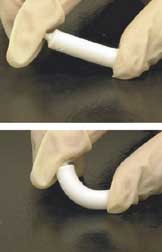
Photo from wikipedia
Various scaffolding systems have been attempted to facilitate vascularization in tissue engineering by optimizing biophysical properties (e.g., vascular‐like structures, porous architectures, surface topographies) or loading biochemical factors (e.g., growth factors,… Click to show full abstract
Various scaffolding systems have been attempted to facilitate vascularization in tissue engineering by optimizing biophysical properties (e.g., vascular‐like structures, porous architectures, surface topographies) or loading biochemical factors (e.g., growth factors, hormones). However, vascularization during ossification remains an unmet challenge that hampers the repair of large bone defects. In this study, reconstructing vascularized bones in situ against critical‐sized bone defects is endeavored using newly developed scaffolds made of chemically cross‐linked gelatin microsphere aggregates (C‐GMSs). The rationale of this design lies in the creation and optimization of cell–material interfaces to enhance focal adhesion, proliferation, and function of anchorage‐dependent functional cells. In vitro trials are carried out by coculturing human aortic endothelial cells (HAECs) and murine osteoblast precursor cells (MC3T3‐E1) within C‐GMS scaffolds, in which endothelialized bone‐like constructs are yielded. Angiogenesis and osteogenesis induced by C‐GMSs scaffold are further confirmed via subcutaneous‐embedding trials in nude mice. In situ trials for the repair of critical‐sized femoral defects are subsequently performed in rats. The acellular C‐GMSs with interconnected macropores, exhibit the capability to recruit the endogenous cells (e.g., bone‐forming cells, vascular forming cells, immunocytes) and then promote vascularized bone regeneration as well as integration with host bone.
Journal Title: Advanced Healthcare Materials
Year Published: 2022
Link to full text (if available)
Share on Social Media: Sign Up to like & get
recommendations!